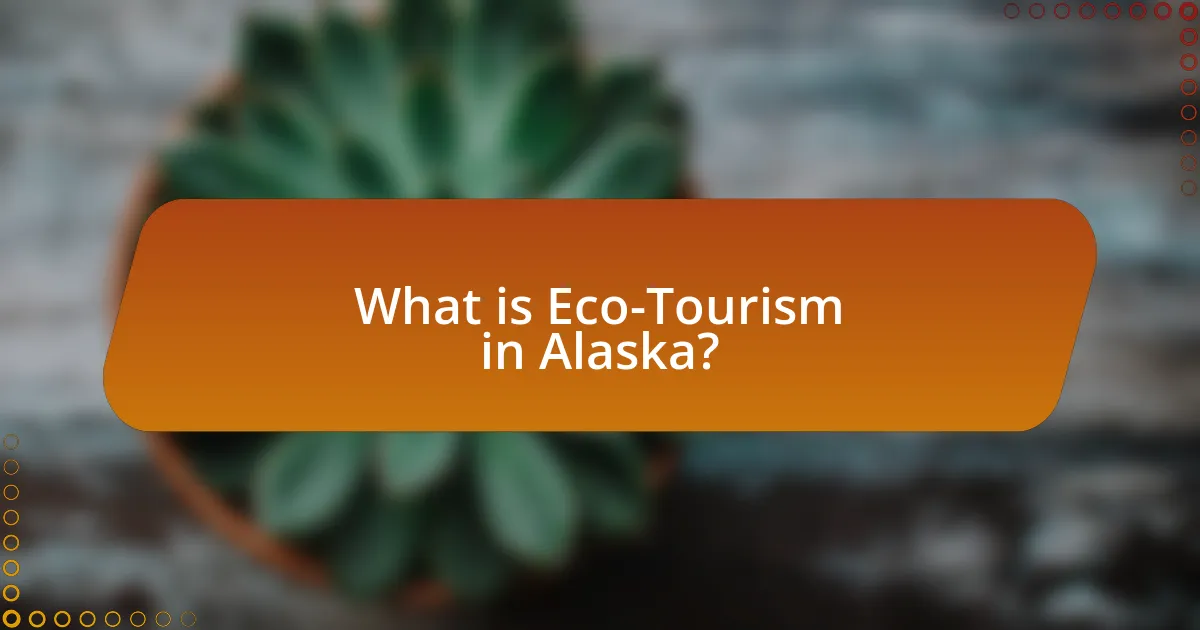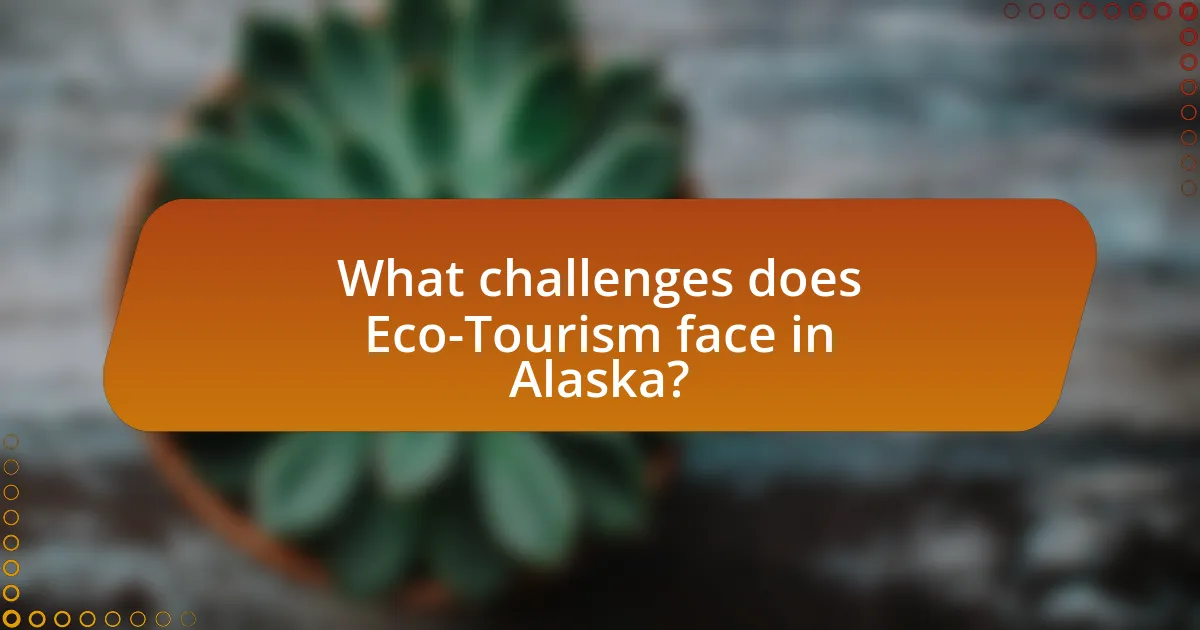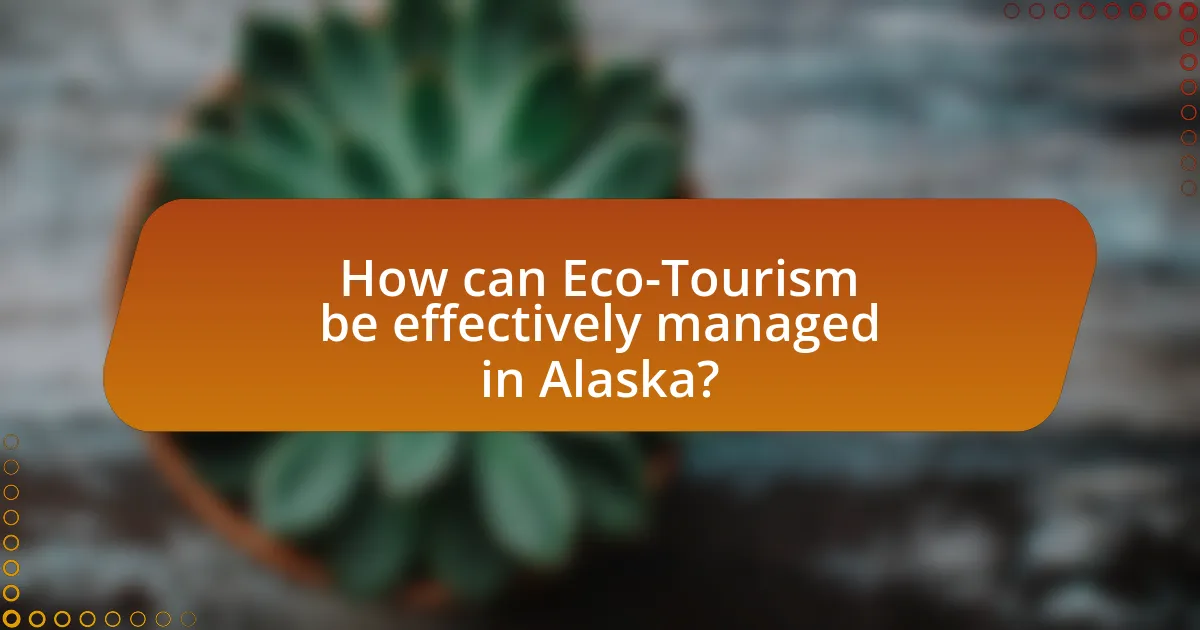Eco-tourism in Alaska represents a sustainable travel approach that prioritizes the conservation of natural resources while providing economic benefits to local communities. This article explores how eco-tourism contributes to conservation efforts, supports specific practices like habitat preservation and wildlife protection, and generates significant revenue for the state. It also examines the economic impact on local sectors, job creation in rural areas, and the challenges faced by eco-tourism, including environmental degradation and climate change. Additionally, the article discusses the social implications of eco-tourism, the role of education, and emerging trends that could shape its future in Alaska, offering practical tips for travelers to support sustainable practices.

What is Eco-Tourism in Alaska?
Eco-tourism in Alaska is a sustainable travel approach that emphasizes the conservation of natural resources while providing economic benefits to local communities. This form of tourism focuses on responsible travel to natural areas, promoting environmental awareness and supporting the preservation of Alaska’s unique ecosystems, such as its national parks and wildlife habitats. According to the Alaska Department of Fish and Game, eco-tourism contributes significantly to the state’s economy, generating millions in revenue while fostering a connection between visitors and the pristine Alaskan environment.
How does Eco-Tourism contribute to conservation efforts in Alaska?
Eco-tourism contributes to conservation efforts in Alaska by generating revenue that supports wildlife protection and habitat preservation. This form of tourism encourages sustainable practices among local communities, as it relies on the natural environment to attract visitors. For instance, eco-tourism initiatives often fund conservation projects, such as the Alaska Wildlife Conservation Center, which rehabilitates injured animals and educates the public about local ecosystems. Additionally, eco-tourism promotes awareness of environmental issues, leading to increased advocacy for conservation policies. According to a report by the Alaska Department of Fish and Game, eco-tourism has become a significant economic driver, with over $2 billion generated annually, directly linking economic benefits to conservation efforts.
What specific conservation practices are supported by Eco-Tourism?
Eco-tourism supports specific conservation practices such as habitat preservation, wildlife protection, and sustainable resource management. These practices are implemented through initiatives that promote responsible travel, ensuring that natural environments are maintained and protected from over-exploitation. For instance, eco-tourism often involves the establishment of protected areas, which can lead to increased biodiversity and the safeguarding of endangered species. Additionally, eco-tourism encourages local communities to engage in conservation efforts, providing them with economic incentives to preserve their natural surroundings rather than exploit them. This approach has been shown to enhance environmental awareness and foster a sense of stewardship among tourists and local populations alike.
How does Eco-Tourism help protect Alaska’s unique ecosystems?
Eco-tourism helps protect Alaska’s unique ecosystems by promoting sustainable travel practices that minimize environmental impact. This form of tourism encourages visitors to engage with nature responsibly, leading to conservation efforts that preserve habitats and wildlife. For instance, eco-tourism initiatives often fund local conservation projects, such as habitat restoration and wildlife protection programs, which are crucial for maintaining biodiversity. Additionally, eco-tourism raises awareness about environmental issues, fostering a culture of conservation among both tourists and local communities. This approach not only safeguards Alaska’s natural resources but also supports the local economy by creating jobs in sustainable tourism sectors.
What economic benefits does Eco-Tourism bring to local communities in Alaska?
Eco-tourism brings significant economic benefits to local communities in Alaska by generating income through tourism-related activities. This sector creates jobs in hospitality, guiding, and conservation efforts, which directly supports local economies. For instance, a report by the Alaska Department of Commerce indicated that eco-tourism contributes over $1 billion annually to the state’s economy, with a substantial portion benefiting rural communities. Additionally, eco-tourism promotes sustainable practices that preserve natural resources, ensuring long-term economic viability for these communities.
Which sectors of the economy are most impacted by Eco-Tourism?
Eco-tourism primarily impacts the hospitality, transportation, and local agriculture sectors of the economy. The hospitality sector benefits from increased demand for eco-friendly accommodations and services, as travelers seek sustainable lodging options. Transportation is affected as eco-tourists often require specialized travel arrangements, such as guided tours and eco-friendly transport methods. Additionally, local agriculture sees a boost as eco-tourism promotes the consumption of locally sourced food, enhancing community engagement and supporting sustainable farming practices. These sectors collectively contribute to economic growth while fostering environmental conservation efforts.
How does Eco-Tourism create job opportunities in rural areas?
Eco-tourism creates job opportunities in rural areas by promoting sustainable travel that relies on local resources and services. This form of tourism encourages the development of local businesses such as guided tours, accommodations, and restaurants, which directly employ residents. For instance, a study by the World Wildlife Fund indicates that eco-tourism can generate up to 30% more jobs in rural communities compared to traditional tourism, as it often requires a higher level of local engagement and resource management. Additionally, eco-tourism initiatives often involve training programs for locals, enhancing their skills and employability in the tourism sector.

What challenges does Eco-Tourism face in Alaska?
Eco-tourism in Alaska faces significant challenges, including environmental degradation, regulatory hurdles, and the impact of climate change. Environmental degradation occurs due to increased visitor traffic, which can lead to habitat destruction and pollution. Regulatory hurdles arise from complex permitting processes that can hinder the development of eco-tourism initiatives. Additionally, climate change poses a threat by altering ecosystems, affecting wildlife populations, and impacting seasonal tourism patterns, which can diminish the appeal of eco-tourism destinations. These challenges necessitate careful management to ensure that eco-tourism can thrive while preserving Alaska’s natural resources.
How do environmental concerns affect Eco-Tourism development?
Environmental concerns significantly influence eco-tourism development by shaping regulations, guiding sustainable practices, and affecting tourist perceptions. For instance, the need to protect natural habitats leads to stricter environmental regulations that eco-tourism operators must follow, ensuring that their activities do not harm ecosystems. Additionally, eco-tourism relies on the preservation of biodiversity, which attracts tourists seeking authentic experiences in nature. According to the World Wildlife Fund, eco-tourism can contribute to conservation efforts, as it often generates funding for environmental protection initiatives. Thus, environmental concerns directly impact the viability and growth of eco-tourism by necessitating a balance between conservation and economic interests.
What are the potential negative impacts of increased tourism on natural habitats?
Increased tourism can lead to significant negative impacts on natural habitats, including habitat degradation, pollution, and disruption of wildlife. Habitat degradation occurs as tourist activities, such as hiking and off-road driving, can damage vegetation and soil, leading to erosion and loss of biodiversity. Pollution from waste, litter, and emissions can contaminate local ecosystems, affecting water quality and harming flora and fauna. Additionally, increased human presence can disrupt wildlife behavior, leading to stress and displacement of species. For instance, studies have shown that in areas with high tourist traffic, species such as bears and moose alter their natural behaviors, which can have cascading effects on the ecosystem.
How can Eco-Tourism mitigate its own environmental footprint?
Eco-tourism can mitigate its own environmental footprint by implementing sustainable practices such as using renewable energy sources, promoting conservation efforts, and minimizing waste. For instance, eco-tourism operators can utilize solar or wind energy to power facilities, which reduces reliance on fossil fuels and lowers greenhouse gas emissions. Additionally, eco-tourism initiatives often include educational programs that encourage visitors to respect local ecosystems and wildlife, fostering a culture of conservation. Research indicates that eco-tourism can lead to a 30% reduction in carbon emissions compared to traditional tourism practices, demonstrating its potential for environmental sustainability.
What are the social implications of Eco-Tourism in Alaska?
Eco-tourism in Alaska has significant social implications, including the enhancement of local communities’ economic stability and the preservation of indigenous cultures. By attracting tourists, eco-tourism generates revenue that can support local businesses and create jobs, thereby improving the quality of life for residents. For instance, a study by the Alaska Department of Fish and Game reported that eco-tourism contributes over $1 billion annually to the state’s economy, directly benefiting local communities. Additionally, eco-tourism promotes cultural exchange and awareness, allowing visitors to engage with and learn from indigenous populations, which can foster respect and appreciation for their traditions. However, it can also lead to challenges such as cultural commodification and potential conflicts over land use, necessitating careful management to ensure that the benefits of eco-tourism are equitably distributed and that local cultures are respected.
How does Eco-Tourism influence local cultures and communities?
Eco-tourism positively influences local cultures and communities by promoting cultural exchange and providing economic benefits. It encourages the preservation of local traditions and practices as communities engage with tourists, fostering a sense of pride and identity. For instance, in Alaska, eco-tourism initiatives often involve indigenous communities sharing their heritage through guided tours and cultural demonstrations, which not only educates visitors but also revitalizes local customs. Additionally, eco-tourism generates income through sustainable practices, allowing communities to invest in education and infrastructure, thereby enhancing their quality of life. According to a study by the World Wildlife Fund, eco-tourism can lead to a 20% increase in local employment opportunities, further integrating communities into the global economy while maintaining their cultural integrity.
What measures can be taken to ensure community involvement in Eco-Tourism?
To ensure community involvement in Eco-Tourism, local stakeholders must be actively engaged in the planning and decision-making processes. This can be achieved through establishing community advisory boards that include representatives from various local groups, ensuring their voices are heard in eco-tourism initiatives. Research indicates that when communities participate in eco-tourism development, they experience increased economic benefits and enhanced environmental stewardship, as seen in successful models like the community-based tourism initiatives in Costa Rica, which have led to sustainable practices and improved local livelihoods.

How can Eco-Tourism be effectively managed in Alaska?
Eco-tourism in Alaska can be effectively managed through sustainable practices that prioritize environmental conservation while promoting local economic benefits. Implementing strict regulations on visitor numbers in sensitive areas, such as national parks, can help minimize ecological impact. For instance, the National Park Service has established limits on the number of visitors to places like Denali National Park to protect wildlife and habitats. Additionally, engaging local communities in eco-tourism initiatives ensures that economic benefits are distributed fairly, fostering stewardship of natural resources. Research indicates that when local populations are involved, such as through guided tours led by Indigenous people, the experience is enriched, and conservation efforts are strengthened.
What best practices should be implemented for sustainable Eco-Tourism?
Best practices for sustainable eco-tourism include minimizing environmental impact, supporting local communities, and promoting conservation efforts. Minimizing environmental impact can be achieved through responsible waste management, using renewable energy sources, and ensuring that tourism activities do not disturb wildlife habitats. Supporting local communities involves hiring local guides, sourcing food and materials locally, and investing in community development projects. Promoting conservation efforts can be facilitated by educating tourists about local ecosystems, encouraging participation in conservation activities, and collaborating with environmental organizations. These practices are essential for maintaining the ecological integrity of destinations while providing economic benefits to local populations.
How can stakeholders collaborate to promote responsible Eco-Tourism?
Stakeholders can collaborate to promote responsible eco-tourism by forming partnerships that integrate conservation efforts with local economic development. For instance, local governments, businesses, and conservation organizations can work together to create sustainable tourism policies that protect natural resources while providing economic benefits to the community. Research indicates that regions with collaborative governance structures, such as the Alaska Sustainable Tourism and Recreation Initiative, have successfully balanced ecological preservation with tourism growth, demonstrating that stakeholder collaboration leads to more effective eco-tourism practices.
What role does education play in fostering sustainable Eco-Tourism practices?
Education plays a crucial role in fostering sustainable eco-tourism practices by equipping stakeholders with the knowledge and skills necessary to implement environmentally responsible strategies. Through educational programs, local communities, tourists, and industry professionals learn about the ecological impacts of tourism, conservation methods, and sustainable practices that minimize environmental degradation. For instance, research conducted by the World Tourism Organization highlights that educational initiatives can lead to a 30% increase in sustainable practices among tourism operators when they understand the importance of biodiversity and conservation efforts. This knowledge empowers individuals to make informed decisions that support both ecological integrity and economic viability in eco-tourism, particularly in sensitive regions like Alaska.
What are the future prospects for Eco-Tourism in Alaska?
The future prospects for eco-tourism in Alaska are promising, driven by increasing global interest in sustainable travel and the state’s unique natural resources. Alaska’s diverse ecosystems, including national parks and wildlife refuges, attract tourists seeking authentic experiences while promoting conservation. According to the Alaska Department of Fish and Game, eco-tourism contributes significantly to the state’s economy, with an estimated $2 billion generated annually from wildlife-related recreation. As climate change impacts the region, eco-tourism initiatives are likely to focus on conservation efforts, enhancing visitor education, and supporting local communities, thereby ensuring sustainable growth in this sector.
How can technology enhance Eco-Tourism experiences while preserving nature?
Technology can enhance Eco-Tourism experiences while preserving nature by utilizing tools such as mobile applications, virtual reality, and data analytics to improve visitor engagement and conservation efforts. Mobile applications can provide real-time information about local ecosystems, guiding tourists to minimize their environmental impact while exploring. Virtual reality experiences can offer immersive educational content about wildlife and habitats, reducing the need for physical presence in sensitive areas. Data analytics can help park management monitor visitor patterns and environmental health, allowing for informed decisions that balance tourism and conservation. For instance, a study by the World Wildlife Fund found that technology-driven visitor management systems can reduce human-wildlife conflict and protect endangered species, demonstrating the effectiveness of these technological solutions in Eco-Tourism.
What trends are emerging in Eco-Tourism that could shape its future in Alaska?
Emerging trends in eco-tourism that could shape its future in Alaska include increased demand for sustainable travel options, a focus on local experiences, and the integration of technology for conservation efforts. The growing awareness of climate change has led travelers to seek eco-friendly accommodations and activities that minimize environmental impact. Additionally, tourists are increasingly interested in authentic cultural interactions with Indigenous communities, which fosters economic growth while preserving local heritage. The use of technology, such as apps for wildlife tracking and virtual tours, enhances visitor engagement and supports conservation initiatives. These trends are supported by data indicating that eco-tourism is one of the fastest-growing sectors in the travel industry, with a projected annual growth rate of 14% globally.
What practical tips can travelers follow to support Eco-Tourism in Alaska?
Travelers can support Eco-Tourism in Alaska by choosing eco-friendly accommodations, participating in guided tours that emphasize conservation, and minimizing their environmental impact. Eco-friendly accommodations often implement sustainable practices such as using renewable energy and reducing waste, which directly contributes to conservation efforts. Participating in guided tours led by local experts helps educate travelers about the ecosystem and promotes responsible wildlife viewing, ensuring that natural habitats are respected. Additionally, travelers should practice Leave No Trace principles, such as packing out all trash and staying on designated trails, to protect Alaska’s pristine landscapes. These actions collectively foster a sustainable tourism model that benefits both the environment and local communities.


